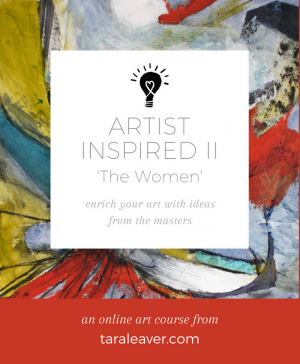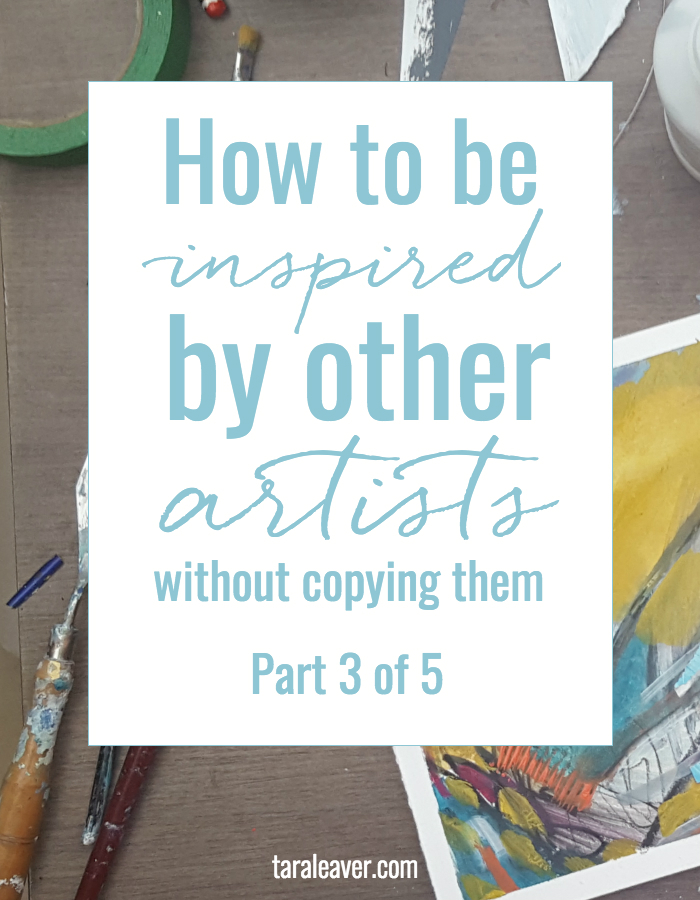This post is the third in a series of five, focused on helping you become ever clearer about what’s unique to you, even while being inspired by other artists.
Continuing our series, today we’re looking at subject matter.
Each week we’ll look at a single aspect of painting and how to tease out the nugget of what’s inspiring you so you can be sure you’re making your own work and not a heavily influenced hybrid or attempted copy of someone else’s.
With a mix of theory and action steps, you can take the ideas and percolate them, or literally try them out for yourself.
I have no doubt there are infinite ways to do this, and in part it will just happen the more you paint, but the ways I find most helpful include a bit of left brain analysis and a breaking down into parts.
The right brain can then rebuild into new things with the new ideas.
3. Borrow their subject matter
There probably isn’t anything in the known universe that hasn’t been interpreted through art at some point.
So as far as that goes you’re unlikely to be doing anything 100% new, which takes some of the pressure of originality off!
And while we can categorise things as still life, figurative, landscape, abstract and so on, those are infinitely flexible containers, and as artists we get to push them to their limits and beyond.
Let’s say you admire an artist who paints flowers. You’ll notice that they don’t reinvent the wheel every time.
They’ve found a certain viewpoint, type of flower, ‘scene’, or some other vehicle and they keep painting it that way, often with just enough variation to keep things interesting, but not enough to render it unrecognisable as theirs.
This is often partly what makes work by certain artists familiar – that commitment to a single subject or way in.
The ‘trick’ to staying interested in that singular approach is to ensure it’s flexible, exciting to you, and allows for evolution. Of course you don’t always know upfront if what you’re about to try fits all those criteria!
That’s why all answers can only be found in actually painting, rather than just thinking and theorising about it.
Sometimes what looks promising turns out to be boring, and sometimes a new door opens while you’re painting that you wouldn’t have found otherwise.
Here are some examples by two artists who focus on one subject and go deep with it:
Erin Gregory

Erin Gregory paints flowers. {She also paints other things, but it’s fair to say flowers are one of her ‘trademark’ subjects.}
You can see her signature in the similar marks, colour palettes, and viewpoint of the vases – off centre and with the flowers bursting off the edges of the canvas.
It’s not that no one’s ever used this perspective before, but the combination of the different elements {plus something else we’ll talk about in a minute} are what makes them hers.
Michelle Armas
Michelle Armas paints abstracts. Again, you can see her signature gestural marks, and a palette – in these paintings – that is similar but not limited.
Her recent work has also expanded into much softer and simpler blooms of liquid colour, but it’s all still within that abstract container.
A suggestion to make it yours:
I’ve seen a fair amount of art that looks very similar to both Erin Gregory and Michelle Armas’ work.
They both have such an appealing aesthetic it’s not really surprising, but it’s also a bummer, both for them and for those who aren’t making their own discoveries.
When you love someone’s work so much you want to do the same thing, try digging deeper into what exactly you love about it.
It’s probably actually much more than just type of marks, palette, etc, although those are likely to be your jumping off point, being tangible. And that’s fine as long as you keep going into your own unknown territory.
But there’s also a FEELING to the work of artists with a consistent and unique style.
Rather annoyingly, that feeling is indefinable and language-resistant!
But you know it when you look at an artist’s work and recognise it. It has a specific feeling.
And the reason for that is because they went deep and long, which started to refine their unique processes and expressions.
It’s not that consistent artists are not interested in other styles – being an artist is synonymous with being infinitely curious – it’s that they found tools – a subject, marks, a palette, a composition – that helps them say something that feels true, and they keep using it and exploring it.
There’s something deeper going on under the surface of what can be seen, something that feels compelling enough to keep exploring through the same filter. And that’s what brings out the uniqueness.
Going deep and long with a specific thing, be it subject, marks, palette, composition, or anything else, allows you to start noticing things you do a lot.
You might love them and feel like they’re ‘yours’, or you might feel they’re more of an old, limiting habit and start looking at ways to evolve them or bring in something new and fresh.
Questions to propel you forward
If you want to paint flowers and you love Erin’s {or insert any artist here} palette and marks, how could you tweak that so it’s not a case of straight up copying and trying to emulate the invisible feeling?
- Could you change the scale or the viewpoint?
- Could you use different colours or media?
- Could you try a different type of bouquet?
If you want to paint abstracts and you love Michelle’s {or insert any artist here} work, again, how can you approach the canvas in a way that is perhaps inspired by her, but not the same?
- How can you practise and evolve your own marks?
- What palette could you use?
- What idea or belief or story or feeling are you wanting to express through abstraction?
It’s ok to not know the answers yet, and it’s ok to trust yourself to discover them as you keep going.
Ultimately the idea is to keep exploring and pushing those flexible edges till you ‘pop’ into something that feels fresh and exciting.
Don’t expect this to happen overnight!
It took you a while to learn to write legibly, and it takes a while for many of us to do the equivalent with paint.
In Part Four, we’ll be talking about the artist’s perspective. Stay tuned!
 I hope this little series has given you some ideas and things to try as you explore what paint can do. If you’d like to play further with other artists’ work in a way that can teach you about your own, then you might like Artist Inspired II.
I hope this little series has given you some ideas and things to try as you explore what paint can do. If you’d like to play further with other artists’ work in a way that can teach you about your own, then you might like Artist Inspired II.
Packed with visuals, videos, ideas to explore, and a look at the life and work of each artist, the course invites you to enjoy being inspired by various female artists as a means to finding your own unique voice as an artist.
Click here to find out more!









Exactly this, except in my case I love to paint guitars so Picasso, Dali, and my friend Bruce Hecksel were my starting point. Then, thanks in part to Abstractify, I mixed in Kandinsky, Chagall, Paul Klee, and more 🙂
Such a great and diverse range of inspirations! And your work is also very much your own. 🙂
I’m just starting to learn to paint and I really appreciate this advice. Thanks so much! 😀
Delighted it’s of help to you Cassie!
found this on Pinterest.. would love to read the last two! Just what I need to hear. Great practical advice, to get me to start trusting myself !!
Glad you found something helpful here Catherine!
What a great article !! Everyone artist needs to read this. It feels like a much bigger accomplishment if the art is truly your own. It takes time and practice to make it your own.
Thank you Karen and I’m so glad you found it helpful!